Consumer Help
A friendly face on tax day
April 11, 2014
By the time zero hour arrived Thursday, the logistics had been locked down for weeks.
Blue vests were freshly dry-cleaned, clipboards loaded up with sample forms and cheat sheets, schedules ironed out with minute-by-minute precision.
All that was missing were the taxpayers. But soon, they showed up as well, completing a biannual ritual that, for the last three years, has sent Kathy Gloster and her team into first floor lobby of the Los Angeles County Hall of Administration to bring order and a touch of TLC to nobody’s favorite task:
Paying property taxes.
“Sometimes there are so many people in the lobby that we have to do crowd control,” said Gloster, a 10-year veteran with the county Treasurer and Tax Collector.
While the crowds were smaller than usual on this year’s April 10 deadline—Gloster hopes and assumes that’s because more people are paying online—the blue vest team was out in force, helping to keep things moving as lines swelled to up to 10 people deep.
Gloster, an assistant treasurer-tax collector, is charged with organizing the collection of the nearly 2.4 million tax bills issued by the county each year. A month ago, she started meeting with her staff to create a schedule for tax supervisors and managers to put in 90-minute shifts in the lobby. Their job is getting taxpayers to the right lines and making sure they have all their paperwork in order. Since property taxes come in two installments—one due on December 10, the other on April 10—the blue vest brigade hits the lobby twice a year to meet a (mostly) accepting public.
“You have people who are really excited because they are paying their first bill on the first property they’ve ever bought,” Gloster said. But others, she said tactfully, “are just maybe not as happy with you as you would like them to be.”
The vast majority of property owners pay by mail, online or by other arrangements, but about 2% come in person—no doubt more aware than anybody of the steep 10% penalty in store for those who pay late.
People love to hate the tax man, but the soft-spoken Gloster insists that she and her team can win most folks over by extending a helping hand.
“When you tell someone you work in the tax collector’s office they say, ‘Oh, you do terrible things,’ ” Gloster said. “But when we get to help somebody, it’s a lot of fun. We can explain things to them.”
Many people come without their bills or, worse, are unable to pay the full amount. “They get that look in their eye that they can’t pay their taxes, and that’s kind of sad.” But the unhappiest taxpayers of all may be those who accidentally show up on income tax day—April 15. At that point, there’s nothing she can do, and the extra 10% is added to the bill. Gloster said she has seen penalties as high as $250,000 for a single parcel.
But most people just want to make their payment and get out of there as quickly as possible, and many offer thanks for the speedy help they receive.
One worker, Ingrid Fontenot, said she enjoys the whole routine.
“It’s a little tiring standing on your feet for an hour and a half, but it’s very fulfilling,” she said. ”I’ve gotten a lot of compliments about our process and how organized we are. It’s a good feeling.”
Meanwhile, the department gets bombarded by phone calls from people with questions about their bills or how to pay online or by mail. Gloster said her department fields about 23,000 calls in the month of April alone.
Gloster also has a cautionary tale for those who pay by mail. If a payment is postmarked by the deadline, it is considered “on time.” However, in this day of QR codes and alternative kinds of stamps, some envelopes don’t get postmarked. Paying online is the best way to make sure the payment is on time, Gloster said, but if you’re mailing it in, it’s a good idea to send it a few days early, just to be safe.
Posted 4/11/14
County has designs on voting
November 13, 2013
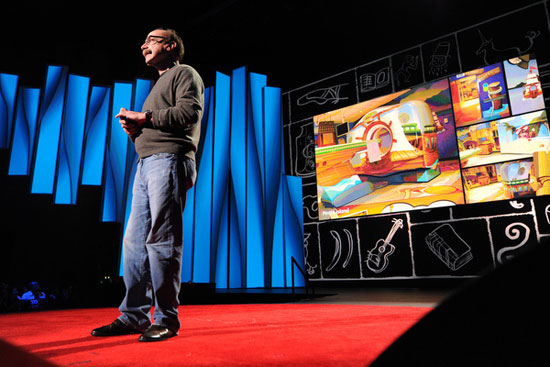
IDEO founder David Kelley has melded utility with elegance in his firm's designs for famous clients.
It’s not easy to re-imagine the largest voting system in the nation, but it doesn’t hurt to have the company behind stand-up toothpaste on your team.
For the past year or so, Los Angeles County has been working closely with IDEO, the innovative Bay Area design firm, to help with the county’s multi-faceted initiative to update its antiquated voting apparatus. The challenge is a big one: The county’s system serves some 4.8 million registered voters in 11 languages at some 5,000 polling places, and is currently using technology that dates, in some cases, to the 1960s.
So in an effort to think creatively about the future, the office of the Registrar-Recorder/County Clerk and the committees guiding the county’s Voting Systems Assessment Project reached out to a firm whose groundbreaking design work goes back to Apple’s first computer mouse in the 1980s.
“We wanted to focus on innovation, and we were attracted by their philosophy of design that’s human-centered,” says Efrain Escobedo, governmental and legislative affairs manager for the Registrar-Recorder/County Clerk’s office. IDEO, he says, studies “what the experience is underlying a project—whether it’s a filling station or a vegetable peeler—rather than just designing around what’s cheapest.”
Created as a merger of four design firms—one in Palo Alto, two in San Francisco and one in London—IDEO, which is now global, specializes in cutting-edge product and organizational design. One of its founders, David Kelley, was close friends with the late Apple co-founder Steve Jobs, whose elegant products became a computer industry standard. But IDEO’s work has run the gamut, from upright dispensers for Crest toothpaste to a rethinking of school lunches.
Initially, Escobedo says, the county learned about IDEO during an experiment with crowdsourcing in which the county put out a call for ideas on the future of voting through OpenIDEO, an online platform and community. But in early 2013, after conducting its own extensive data-gathering process, the county engaged the company’s consultants to help analyze the research under a series of short-term agreements worth about $1 million.
Among IDEO’s objectives is a rethinking of the traditional voting machines so they not only accommodate voters in a multiplicity of languages and settings, but are also universally accessible no matter the voter’s age, education, familiarity with the process or physical abilities.
“We’ve delivered three really, really rough concepts that we’re working now to whittle down into one,” says Sarah Rienhoff, IDEO’s public sector lead on the voting project. Visual renderings and mock-ups have ranged from boxy one-stop, hands-free voting stations to lightweight podium-like contraptions that can be easily moved around by poll workers and stored.
To augment data the county gathered, IDEO consultants examined on their own the extremes of the voting spectrum—newly naturalized citizens, older voters, young voters, people who had stopped voting and people with physical limitations that impacted their use of the existing system.
That last group was especially important, in part, because advocacy groups for the disabled have sued over issues such as the lack of touch-screens and the paper ballot requirement—mandates that, they contend, make voting harder and less private for visually-impaired voters.
So, Rienhoff says, the group put a special emphasis on disabled voters. One focus group brought county staffers nearly to tears as a man with cerebral palsy talked about the alienation of being shunted off to vote in a separate booth for handicapped people.
Another exercise took the form of an educational field trip.
“We did ‘dining in the dark’ at Opaque, a restaurant in Santa Monica where all the [servers are] visually impaired or blind and the customers eat in a fully dark dining room,” says Rienhoff, adding that they went back the next day to interview their waiter—one of more than 44 individual interviews they conducted last spring.
The IDEO group also studied lottery kiosks as an example of a system in which decision-making is paired with convenience and observed elections in Pasadena and Compton to compare voting in diverse communities.
What’s more, the firm’s creative approach served to inspire the Registrar-Recorder staff, Escobedo says. Among other things, they created an “idea wall” in the executive office in Norwalk after visiting IDEO’s workspace.
As the project’s self-imposed 2016 deadline approaches, some broad outlines have begun to take shape. For one thing, Escobedo says, it is clear that the new system won’t include voting via Internet or smart phone, at least for now, due to security concerns.
That, however, doesn’t preclude the possibility of the vote-by-mail option morphing someday into a scanned ballot sent by encrypted email, or a digital tablet onto which voters can electronically upload their pre-marked decisions. Also, look for bigger ballots, voting machines with universal design and hands-free access and possibly a voting process that revolves less around a single day at a single polling place than, say, a 2-week voting “window” or community voting centers.
“By the end of the year, we hope, we’ll have an actual final design concept that we can begin to engineer,” says Escobedo, who expects to start prototyping some time next year.
One aspect of the process is unlikely to change, however: That little “I Voted” sticker?
“Oh, that’s a mandatory do-not-leave-out,” laughed Escobedo. “People love that. It’s not going anywhere.”
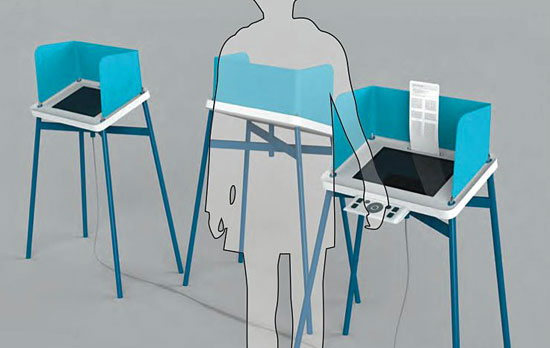
One possibility for future voters might be more portable voting machines, as seen in this IDEO rendering.
Posted 11/13/13
Undercover shoppers ring up retailers
May 9, 2013
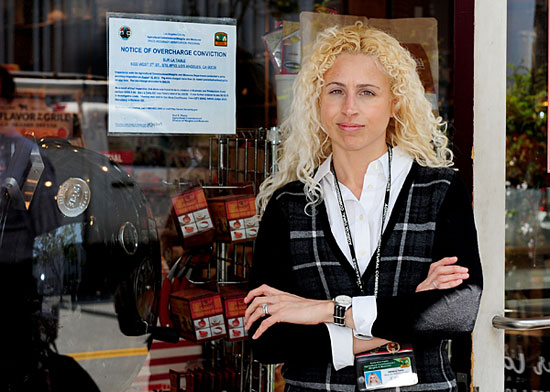
“Buyer Beware” supervisor Katherine Takata outside a Sur La Table store at The Grove that overcharged.
“Men’s Shorts Now $49.50.” The sign at the J. Crew was clear. But when the knee-length summer pants were rung up last year on a Tuesday morning, the scanner read $64.50.
It was a costly mistake—for the merchant. The “shopper” was an inspector from the county’s “Buyer Beware” program, and the $15 error, along with a mistake in the store’s favor on a pair of T-shirts, added up to a misdemeanor. Now, more than $3,200 in fines and investigative costs later, Mother’s Day bargain hunters will find a different eye-catching sign in that J. Crew, in Glendale’s Americana at Brand shopping center.
“Notice of Overcharge Conviction,” it says.
Signed by the county’s Agricultural Commissioner/Director of Weights and Measures, the 8½-by-11-inch notices have quietly become a part of L.A.’s shopping landscape in the decade since the county first began mandating their display.
Today, the county has 16 full-time inspectors working on price verification, funded by some $2 million a year in fees, says Deputy Sealer of Weights and Measures Katherine Takata, who oversees the program. Inspectors have found overcharges everywhere from supermarkets and drug stores to the handbag department of the Beverly Hills Neiman Marcus, where, in late 2011, scanners were caught charging $990 for a Prada handbag that was supposed to be on sale for $910.
Some inspectors visit retailers as anonymous shoppers or respond to consumer complaints; others show up unannounced and conduct annual spot checks.
Diplomacy also is part of the job for the inspectors, who, like traffic cops, never know what they’ll encounter.
“People cry,” Takata says. “People get angry. We’ve had people try to hug us if they pass the inspection. Someone fainted once when the inspector identified herself. Another time, an inspector asked a store manager in the Beverly Center for an ID and the man excused himself and came back a half-hour later, all sweaty—he’d run all the way back to his house to get it.”
The job does have its entertaining moments.
“We’ve had celebrity sightings,” she says. “We’ve been in store parking lots during shootings. One of our inspectors was at a Victoria’s Secret once, checking prices, and one of the clerks asked him if he wanted a changing room.” Two inspectors once foiled a robbery at a Rite-Aid by blocking the exits, she says, and several undercover inspectors have themselves been mistaken for shoplifters.
When the inspections pay off, however, they can yield serious victories for consumers. Early this year, for instance, the legwork of L.A. County inspectors helped win a multi-county, $875,370 ruling against Best Buy. As part of the settlement, the retailer has to give California customers a $3 discount if they discover any more erroneous charges.
“Most overcharges occur because of human error—things like expired price tags not being taken down or updated in the system,” Takata says. “Sometimes it’s just a regularly priced item sitting on their shelf, and you bring it to the cash register and it rings up incorrectly. Sometimes it’s clearance items that haven’t been marked properly in the system.”
Innocent as the errors may be, however—the store manager at the J. Crew cited a computer malfunction when a routine spot check turned up those overcharges—the state holds retailers responsible for the accuracy of their prices. State law forbids merchants to charge more than the lowest price advertised.
Overcharges of less than $1 are infractions, carrying fines of up to $100 per violation, but overcharges of more than $1 can be prosecuted as misdemeanors, with penalties of up to $1,000 per violation.
“It may seem like a small thing,” says Takata. “But for, say, a retiree on a fixed income, even a dollar is significant. And for big companies like Ralph’s or Best Buy, these fines are a drop in the bucket. These overcharges add up. When Macy’s overcharges by dollar for a tie, it isn’t just that one tie and that one dollar. It’s all the people who buy that tie at Macy’s.”
Last year, she says, the program collected nearly $271,000 in fines from misdemeanor prosecutions, nearly $67,000 for investigative costs and nearly $99,000 in civil administrative penalties. At the moment, she says, notices are fluttering from the doorways of about 80 retailers across the county.
Over the years, Takata adds, those signs have been a special source of consternation for some merchants, who complain that they deter business. Because they are specifically written into the county ordinance that created Buyer Beware, however, businesses must display them.
“We try to work with people, but there’s not a lot of wiggle room,” she says.
The county’s overcharge notices, required by law to hang within five feet of a retailer’s front door for 60 days after a conviction, were conceived in an effort to ensure accurate pricing after Supervisor Gloria Molina complained about overcharges at a Macy’s and a Kmart during the 2001 holiday shopping season. At the time, only one full-time inspector had been assigned to monitor pricing accuracy at the more than 10,000 merchants who do business here.
A subsequent investigation found overcharges at two-thirds of 108 retailers sampled around the county, and that spawned the Buyer Beware program, which requires stores to register price scanners and pay a fee that, in turn, underwrites the scanner inspection program. The blue-and-white overcharge notices—variously regarded as something between a restaurant grade and a scarlet letter—were added at the end of a yearlong grace period after the inspections were launched in 2002.
ACWM spokesman Ken Pellman compares the signs to speeding tickets. “The enforcement prevents larger problems and keeps things orderly,” he says. Like speeding tickets, he adds, they have also worked well as a deterrent. Last year, only about 17 percent of the 8,459 retailers inspected were caught overcharging.
Overcharging, he says, “is still unfortunately a common problem, but it’s less common than it used to be.”
Posted 5/9/13
Don’t buy—hop to the rescue
March 28, 2013

The Easter season floods county shelters with unwanted bunnies. Maggie Mae, above, needs a good home.
The bunnies are coming—chocolate ones, marshmallow ones, stuffed ones and sometimes, real live ones. While the first three can be quickly devoured or tossed on a pile of toys, the real ones are more complicated. They may look adorable on Easter morning, but they require lots of love, care and attention over a 10-year lifespan.
Evelina Villa of Los Angeles County’s Department of Animal Care and Control has seen first-hand what happens when pet rabbits are poorly cared for.
“Usually they are sick,” she said. “Sometimes they are so ill that we have to euthanize them.”
Even worse, Villa said, some owners simply set the bunnies free when they no longer want to take care of them. Domesticated rabbits are ill-equipped to handle the wild. Most get eaten by predators within 72 hours, and they also suffer from parasites and other infections. Beyond that, abandoning pets—rabbits included—is illegal, carrying fines of $500 and up to 5 months in jail.
“It is better to bring them to us so we can try to re-home them instead of trying to let them fend for themselves,” Villa said.
But it should never come to that. The county agency is currently offering two alternatives to making impulsive pet purchases this Easter.
First, unless you’re prepared for a serious, long term commitment, don’t buy a pet rabbit in the first place, especially as a gift for children. Stick with the chocolate or plush variety. While the animals can make great domestic companions, young kids aren’t usually their best friends. Rabbits are fragile, and well-meaning cuddles and snuggles tend to freak them out, according to the American Society for the Prevention of Cruelty to Animals. And, because rabbits can’t bark or meow, they tend to bite and scratch in self-defense. A rabbit is a real pet, just like a dog or a cat. It requires a lot of care and costs about $675 annually for vet visits, food and other supplies.
But if you’ve done your research and have decided you are ready to make the, er, hop into rabbit ownership, county shelters are offering another option: adopt a shelter bunny for just $25. You’ll save a life, and in the process you’ll receive a pet that’s already been examined by a vet, microchipped and spayed or neutered.
There are currently 67 rabbits at county shelters, a number that will likely surge after Easter Sunday, Villa said. Thirty rabbits were surrendered in just one week after last Easter. Fortunately, with promotions like this and the assistance of local rabbit advocates, the department is usually able to find homes for the healthy ones.
Abandoned bunnies aren’t just an L.A. problem. From the House Rabbit Society to The Rabbit Haven, advocates across the country are sounding the alarm: buying a pet rabbit for a gift is almost always a bad idea.
To adopt a rabbit, go to one of six county Animal Care Centers. But, before you go, make sure you’re ready to give your new pet the care it deserves. Otherwise, you’re better off with Peeps.

Bob Dylan, above, knows how it feels to be without a home, like a complete unknown. Make this cuddly rolling stone your own.
Posted 3/28/13
Have they got a deal for you
September 27, 2012
Sure, you could sit around and mope all weekend, fretting about the 53-hour closure of the 405 Freeway.
Or you could come out of Carmageddon II with a free bagel, a discounted letterman jacket and some newfound pole dancing skills.
Already feeling separation anxiety from your car? A complimentary 15-minute chair massage from Physical Therapy Solutions could help you cope. Fear of driving in a post-Carmageddon world? Hypnosis might work, and the price of the first session is 50% off at Scripting Your LifePlay.
As Los Angeles prepares to confront a second Carmageddon weekend on Sept. 29-30, the discounts, freebies and special offers are flying. Many neighborhood businesses are hoping for a boost from local customers sticking close to home for the weekend, as well as from those ditching their cars in favor of public transportation to get to attractions and services throughout the region.
Metro, which along with Caltrans is responsible for the massive 405 improvements project that includes Carmageddon II, has been working feverishly to turn the lemon of a lengthy freeway closure into some sweet, bargain-hunting lemonade.
An unprecedented expansion of the agency’s 10-year-old Destination Discounts program has brought hundreds of businesses into a special Carmageddon-themed initiative, complete with interactive map.
“To just say to people ‘eat/shop/play locally’ is not enough. It needed to have legs, it needed to have incentives attached to make it real, to make it viable,” said Fran Curbello, the Metro communications manager heading up the initiative. “We gave our business community a chance to be part of the solution.”
While some of the deals require presentation of a Metro TAP card, other businesses are extending their discounts and freebies to all comers this weekend—no questions asked.
At Select Beer Store in Redondo Beach, for instance, customers can just say “Carmageddon” to claim a free bag of chips as they order a brew (while supplies last!)
Although Metro’s primary objective is to get people riding public transit, it also has an interest in helping folks find diversions close to home this weekend. Curbello suspects that most merchants won’t particularly care whether their customers arrive by bus, bike or (gasp) automobile, as long they’re staying in the neighborhood—and away from the 405 construction zone.
“It’s good business,” she said.
The participants range from mom-and-pop eateries to big hotels and major museums. The Los Angeles County Museum of Art, for example, is offering ½ price admission to everyone who comes “via an alternate mode of transportation.” At another point on the artistic spectrum, Madame Tussauds Hollywood is having some fun with numbers and offering a 40.5% discount (get it?) on adult and children’s tickets. (Enter promo code 4050 if ordering online.)
Even for armchair bargain-hunters, Metro’s interactive Eat/Shop/Play map is worth a few clicks, just to marvel at the idiosyncratic glories of Los Angeles itself as it goes on sale for the weekend.
There are traveling notaries (J Lawson Mobile Notary of North Hollywood) and educators who make house calls (Tutor Doctor of Van Nuys.) There are horses to ride at the Sunset Ranch near the Hollywood sign and Segways for hire in the South Bay. Xtreme Martial Arts is offering discounts in North Hollywood and Rise-The Studio in Santa Monica is pushing 25% off all its “meditative and playful pole dancing classes” on Sept. 29 and 30.
Then there’s the food. Lots of it.
Most of the participating restaurants are offering discounts, but many are throwing in freebies.
“I’m ready to give away some hot links, that’s what I’m gonna do,” said Kevin Huling, owner of Les Sisters Southern Kitchen in Chatsworth, who’s hoping the new Orange Line extension will help bring customers his way. “I am hoping more people come down here. It’s a bit of a walk, but we’re walking distance from the Chatsworth Station.”
The moveable feast also includes free naan bread at Saffron in the Baldwin Hills Crenshaw Plaza, an on-the-house bagel for transit riders at the Onegeneration booth at the Encino Farmers Market, and a free side dish or beverage at Mel’s Fish Shack on West Jefferson, near the Expo Line’s Farmdale Station.
Those seeking a more lasting souvenir of Carmageddon II might consider making an automotive style statement with tire rims from EZ Rims 4 Rent on Crenshaw Boulevard. For this weekend, they’re offering $50 off purchase and rent-to-own transactions.
“Hopefully it does pretty well,” manager Fidel Ozuna said. “We are anticipating a pretty decent weekend.”

Have you seen The Rock yet? LACMA's half price this weekend if you get there via alternate transportation.
Posted 9/27/12
Love, out of the box
February 8, 2012
Sick of dropping sixty bucks on a few measly roses? This year, treat your valentine to tens of thousands of live flowers on a romantic stroll through one of the breathtaking public gardens of Los Angeles County.
Love certainly won’t be the only thing blooming at Los Angeles County Arboretum & Botanic Gardens. Magnolias, the largest flower outside of the tropics, will be in full blossom. The gardens have more than 60 varieties. Magnolias have been cultivated for more than 1,400 years in China, where monks arranged them in temples to represent the female yin, purity and truthfulness. Orchids will also be showcased. Three thousand of the best ones will be brought in for display among the waterfalls of the tropical greenhouse.
The grounds at the arboretum are a big part of the attraction, from the ornate Queen Anne Cottage to the community garden. Resident peacocks, egrets and other wildlife will keep you company as you explore the lush environment.
If you plan on celebrating early—and if your valentine is a fungi fancier—the arboretum will host the popular Wild Mushroom Fair on Sunday, February 12. There will be displays, growing lessons and cooking demonstrations, along with mushroom-relevant books, collectibles and art for sale. For $10 per person, guests can attend a lecture from mushroom guru Gary Lincoff. Proceeds benefit the Los Angeles Mycological Society.
Over at Descanso Gardens, the camellia will take center stage. Descanso boasts the largest collection of camellias in North America, and the blossoms are at their very best during February. Cherry trees, magnolias and daffodils are also blooming.
Descanso has special activities planned for Valentines Day. For $25 a couple, a “Tram Tour of Love” will take lovebirds to all the best spots. You can reserve seats for a 3 p.m. or 4 p.m. excursion. That evening, a three course holiday dinner will be served in the Boddy House, a 22-room hilltop mansion with a panoramic view of the San Gabriel Mountains. Reservations are $78 per person.
If you’re looking for something a bit smaller-scale, the Italian terrace at Virginia Robinson Gardens will have camellias, pansies, violas and pink rock roses, all in bloom. The gardens are located on the historic estate in
Beverly Hills, built in 1911. Tours are by appointment only; call (310) 550-2087 to make a reservation.
Walking tours of gardens are a healthy and inexpensive alternative to the traditional consumerism of Valentine’s Day. But if the money you save still burns a hole in your pocket, consider showing some love to the Arboretum to help it fully recover from damage done by a strong Santa Ana windstorm in December.
Posted 2/8/12
Resolve to check out these freebies
December 29, 2011
Whether you overspent this holiday season or just made a New Year’s resolution to be thriftier, have we got some deals for you.
Looking for a free supply of nicotine patches?
The Los Angeles County Department of Public Health has you covered, as part of its L.A. Quits program to help smokers kick the habit. (Call 1-800 NO BUTTS to get a one-month supply, gratis.)
Public Health also offers a wealth of other freebies, ranging from “Germbuster Activity Books” for kids to in-home tests for sexually transmitted diseases. HIV tests are free, too. And so is a remarkably comprehensive library of downloadable educational brochures, on topics from antibiotics and bed bugs to West Nile virus and whooping cough.
Cultural bargain-seekers are in luck as well. The Los Angeles County Museum of Art is offering free admission on Monday, January 16, in honor of Martin Luther King Jr. Day. LACMA’s “Andell Family Sundays” program resumes on January 8, with a free-with-admission art-making project called “Circle of Animals.”
More free art-making and performances are offered through “World City at the Music Center.” Next up: Khac Chi Ensemble & Korean Classical Music and Dance Company on Saturday, January 15.
Another source of potential giveaways is the Department of Public Works, which has been known to hand out free sandbags at fire stations during the rainy season as well as other freebies ranging from free oil filters to reusable shopping bags (every shopper’s must-have accessory to keep up with the county’s plastic bag ban.) Check the department’s Clean LA website to learn about upcoming events featuring giveaways in your area—as well as recycling programs for tires and motor oil and hazardous waste and electronics roundups.
But wait, there’s more! Some lucky gardeners will have a chance to win a free composting bin at one of Public Works’ upcoming Smart Gardening workshops. (Look for the green-starred events on this list.) And the county’s Waterworks Districts also give out conservation-minded freebies such as low-flow showerheads and high efficiency water nozzles; check here for more information, and download a colorful brochure on drought-tolerant plants while you’re at it.
There’s more than simple generosity behind all this county largess. The giveaways are intended to influence behavior—for the greater good.
As Public Works spokesman Michael Kaspar put it: “We’re encouraging people to integrate sustainable, environmental practices into their everyday lives.”
Posted 12/29/11
Spot a pothole? Give it “The Works”
December 7, 2011
If you’ve ever wished you could zap a pothole or wipe out some graffiti, the county Department of Public Works has a message for you: the power’s in your hands.
Or, to be precise, on your iPhone.
The department’s new “The Works” app offers a point-and-shoot approach to cleaning up quality of life nuisances in county territory, including illegal dumping and street sweeping issues.
Once the free app is downloaded, you can use the camera on your iPhone to send Public Works an instant image of the problem, get a ticket number and keep tabs on how the issue is resolved. (It’s also possible to send a message about the problem without including a photo.) If the location is not within the county’s jurisdiction, the app detects that and directs the customer to the appropriate agency. Jesse Juarros, the department’s chief information officer, said the “end game” is eventually to get all cities within L.A.County to join up so that reports can be forwarded seamlessly to the right place.
Since it was launched Oct. 18, the app has been downloaded 700 times—with more than 330 service requests received, including referrals to other cities.
“Most of them are for potholes, as you’d expect,” Juarros said. “The other one that ranked up there was illegal dumping.”
The new app is “definitely” contributing to quicker graffiti removal, Juarros said, because notifications go directly to clean-up contractors, who can take action right away.
Droid or Blackberry users can take advantage of the same services through the department’s mobile site. And they’re available to all via the regular DPW website.
Posted 11/9/11
Report your wind damage now
December 7, 2011
The monster winds have blown out of town but now Los Angeles County residents are facing a massive clean-up operation. If your property suffered any kind of damage in the windstorm, the county Office of Emergency Management wants to hear from you.
They’re hoping to receive information from everyone who sustained damage, regardless of which city or part of the county they live in. In addition to information about what was damaged, they also want to know whether you have insurance to cover all or part of the losses.
The information will help the county complete an initial damage estimate—information which could help it to qualify for state and federal assistance, such as low-interest loans to property owners.
Residents and business owners from the 3rd District, as well as other parts of the county such as the hard-hit San Gabriel Valley, are encouraged to report their wind damages as soon as they can. Those with internet access can fill out a simple wind damage form here. Reports can also be made by calling 211, or the county’s disaster hotline, 1-800-980-4990.
The winds, which gusted at speeds approaching 100 miles per hour, toppled hundreds of trees, closed roads and schools and left hundreds of thousands of people without electricity. A county state of emergency has been in effect since Dec. 1. In the aftermath of the windstorm, those who want to prepare for whatever the next disaster will bring can check out an array of county resources here.
Posted 12/7/11




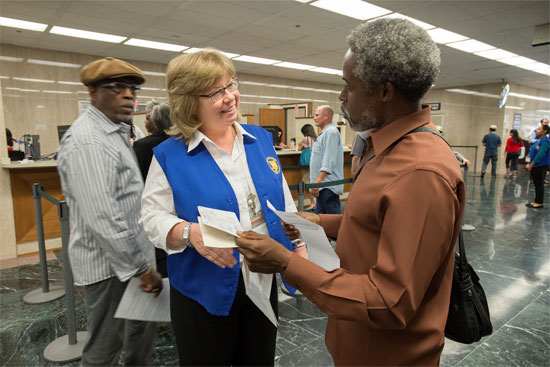
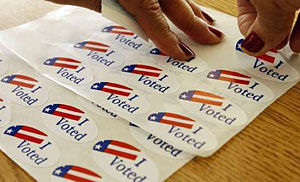
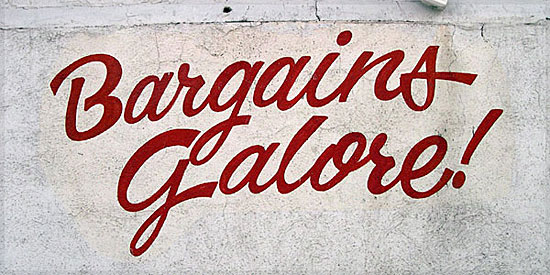


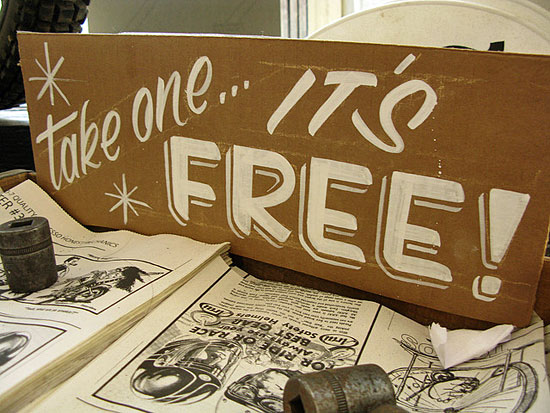

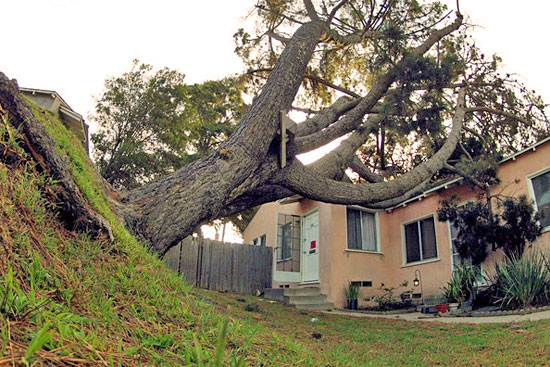







 405 bridge work causes a stink
405 bridge work causes a stink
